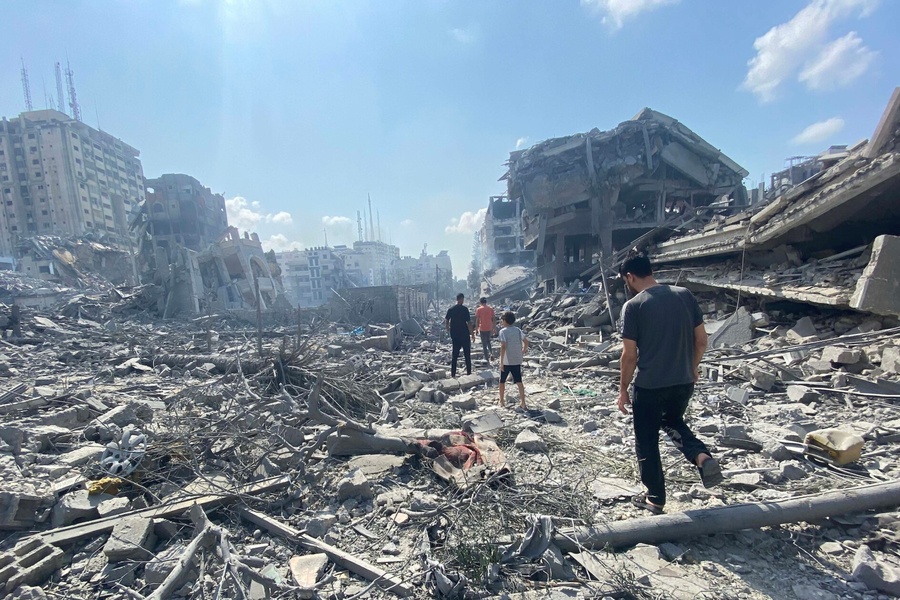Trump’s Iran Statement: The (Non)Action Items
President Trump yesterday announced that he will decline to certify to Congress that Iran is in compliance with the JCPOA and that the implementation of the agreement remains in the U.S. interest, as the Iran Nuclear Agreement Review Act (INARA) requires him to do by October 15.
Published by The Lawfare Institute
in Cooperation With

President Trump yesterday announced that he will decline to certify to Congress that Iran is in compliance with the JCPOA and that the implementation of the agreement remains in the U.S. interest, as the Iran Nuclear Agreement Review Act (INARA) requires him to do by October 15. He said that Iran “is not living to the spirit of the deal,” and that the “Iranian regime has committed multiple violations of the agreement.” The latter statement contradicts the positions of the other parties to the agreement, who maintain that so far Iran has complied with its nuclear obligations under the JCPOA, as well as the determinations of the International Atomic Energy Agency (IAEA).
As expected, however, Trump left it to Congress to decide whether to actually unravel the JCPOA by re-imposing nuclear sanctions that were lifted under the framework of the agreement, or by unilaterally backing out of key U.S. commitments. As I previously explained, absent additional executive or congressional measures, decertification alone does not trigger any automatic consequences for the continued implementation of the U.S. commitments under the JCPOA (see also Tess Bridgeman and Marty Lederman’s analysis at Just Security). At the same time, Trump threatened that he would exercise his power to terminate U.S. implementation of the nuclear deal should Congress fail to act:
… in the event we are not able to reach a solution working with Congress and our allies, then the agreement will be terminated. It is under continuous review, and our participation can be cancelled by me, as President, at any time.
Trump’s statement was packed with tough rhetoric and criticism of Iran’s support for terrorism, its meddling in the Middle East and elsewhere, its ballistic missile program, and its record of human rights abuses. But it contained only two concrete action items: the designation of Iran’s Revolutionary Guard Corps (IRGC) and additional Iranian entities; and the endorsement of a legislative effort to augment or “fix” the JCPOA. That effort appears to be led by Senator Bob Corker, the chairman of the Senate Foreign Relations Committee, and Senator Tom Cotton. As demonstrated below, the scope of both of these measures is far more limited than Trump’s statement would indicate.
The IRGC Designation
In conjunction with Trump’s statement, the U.S. Treasury Department’s Office of Foreign Asset Control (OFAC) designated Iran’s Revolutionary Guard Corps (IRGC) pursuant Executive Order (E.O.) 13224 on international terrorism, and “consistent with the Countering America’s Adversaries Through Sanctions Act.” (for an overview of E.O. 13224, see Ed Stein and Zac Copeland’s posts). According to OFAC’s statement, the IRGC was designated for supporting the activities of the Quds Force, a paramilitary unit of the IRGC. The Quds Force was itself designated in 2007 under the same Executive Order for supporting a number of terrorist groups. In addition to the IRGC, OFAC designated four entities under E.O. 13382, which targets weapons of mass destruction proliferators and their supporters. There are a few important things to note about those new designations.
First, the new designations (and any new non-nuclear sanctions, for that matter) are technically in line with the JCPOA. The JCPOA only covers nuclear obligations and sanctions. Yesterday’s designations, like previous non-nuclear Iran sanctions that the U.S. has imposed post-JCPOA (see, for example, below and here), are based on involvement in terrorism, meddling in Syria, and involvement in proliferation of weapons of mass destruction (including missile technology) – all activities that fall outside the scope of the nuclear deal. As the guidance issued by the Obama administration on JCPOA implementation day (January 16, 2016) made clear (p. 4):
The USG commitment to lift sanctions described in the JCPOA is without prejudice to sanctions that may apply under legal provisions not included within the scope of section 4 of Annex II of the JCPOA… the USG retains the authority to continue imposing sanctions under authorities not included within the scope of section 4 of Annex II, including those used to address Iran’s: support for terrorism, support for persons involved in human rights abuses in Syria or for the Government of Syria, support for persons threatening the peace, security, or stability of Yemen, human rights abuses, and ballistic missile program.
(Similarly, while Trump urged U.S. allies to impose additional sanctions against Iran, he limited the call to “sanctions outside the Iran Deal that target the regime's ballistic missile program, in support for terrorism, and all of its destructive activities, of which there are many.”)
Second, yesterday’s IRGC designation does not set a precedent, contrary to the impression Trump’s statement and some news reports may have created. Trump said that “[t]he execution of our strategy begins with the long-overdue step of imposing tough sanctions on Iran’s Islamic Revolutionary Guard Corps.” In fact, the IRGC has been on OFAC’s Specially Designated Nationals (SDN) list for quite a while under multiple sanctions programs. As OFAC’s press release notes, the IRGC was previously designated in 2007 pursuant to E.O. 13382 for supporting Iran’s ballistic missile and nuclear programs; in 2011 pursuant to E.O. 13553 for its role in human rights violations; and in 2012 pursuant to E.O. 13606 for similar reasons. All three executive orders are not among the orders the Obama administration revoked as part of the implementation of the JCPOA (see pp. 3, 37-40 of the implementation day guidance).
A look at the Countering America’s Adversaries Through Sanctions Act cited in OFAC’s press release reinforces this observation. The bill, signed by President Trump this past August, provided for additional sanctions against Iran, Russia and North Korea among other provisions (see Ed Stein’s explanation of the Act). With regard to Iran, title I of the Bill introduced additional sanctions related to Iran’s ballistic missile program, involvement in terrorism and human rights abuses. Section 105 of the Bill, which specifically addresses terrorism-related sanctions with respect to the IRGC, recognized that the IRGC was already designated at the time of the Bill’s enactment, and had been for a long time:
(a) FINDINGS.— Congress makes the following findings:
(1) The IRGC is subject to sanctions pursuant to Executive Order No. 13382 (50 U.S.C. 1701 note; relating to blocking property of weapons of mass destruction delivery system proliferators and their supporters), the Comprehensive Iran Sanctions, Accountability, and Divestment Act of 2010 (22 U.S.C. 8501 et seq.), Executive Order No. 13553 (50 U.S.C. 1701 note; relating to blocking property of certain persons with respect to serious human rights abuses by the Government of Iran), and Executive Order No. 13606 (50 U.S.C. 1701 note; relating to blocking the property and suspending entry into the United States of certain persons with respect to grave human rights abuses by the Governments of Iran and Syria
via information technology)
Sections 105(b) and 105(c) then instruct the president to impose additional sanctions against the IRGC pursuant to E.O. 13224. That is what was done yesterday. But considering that the IRGC ‘s property was already blocked as a result of the previous designations, yesterday’s designation seems to add little more than a symbolic statement about the IRGC’s role in supporting and promoting terrorism.
All this being said, as Treasury Secretary Steven Munchin stated in the press release about the new designations, the IRGC “permeates much of the Iranian economy.” It is a powerful entity that plays a central role in the realization of Iran’s agenda on many fronts. The administration’s publicized actions with respect to the IRGC yesterday, the practical legal significance of which is limited, contributes to the escalation of tensions with Iran at the diplomatic level that could undermine the JCPOA.
The Corker-Cotton Plan and “Fixing” the JCPOA
Interestingly, Trump issued a signing statement upon signing the abovementioned Countering America’s Adversaries Through Sanctions Act. In the statement he expressed concern about “the many ways” in which the Act “improperly encroaches on Executive power.” “The bill remains seriously flawed,” he continued, “particularly because it encroaches on the executive branch’s authority to negotiate.” Yesterday, President Trump seemed far less concerned about the prospect of Congress limiting the president’s discretion where it comes to Iran negotiations:
That is why I am directing my administration to work closely with Congress and our allies to address the deal’s many serious flaws so that the Iranian regime can never threaten the world with nuclear weapons. These include the deal’s sunset clauses that, in just a few years, will eliminate key restrictions on Iran’s nuclear program.
The flaws in the deal also include insufficient enforcement and near total silence on Iran’s missile programs. Congress has already begun the work to address these problems. Key House and Senate leaders are drafting legislation that would amend the Iran Nuclear Agreement Review Act to strengthen enforcement, prevent Iran from developing an inter- -- this is so totally important -- an intercontinental ballistic missile, and make all restrictions on Iran’s nuclear activity permanent under U.S. law. So important. I support these initiatives.
The main legislative effort currently under way seems to be the Corker-Cotton plan, titled “Fixing the Iran Deal.” (Of course, the JCPOA can’t actually be unilaterally “fixed.”) The plan includes automatic “snapback” of U.S. sanctions if Iran goes under a one-year “breakout” capability, that is, the ability to manufacture a nuclear weapon. It also contemplates restrictions on Iran’s nuclear program that would ignore the JCPOA’s “sunset” provisions as they apply to U.S. sanctions. The document does not say anything about amending INARA as Trump suggested, nor does it mention any specific elements that would combat “the full spectrum of Iran’s nefarious activities.” It does say that the proposed legislation “would not conflict with the JCPOA upon passage.”
In light of this, it is difficult to say at this point whether the product of this legislative effort, if successful, would necessarily contradict any of the commitments the U.S. undertook under the JCPOA. For example, if the restrictions contemplated by the Corker-Cotton plan would only address specific nuclear weaponization activities and missile development, they would arguably be in line with the JCPOA. As previously mentioned, the JCPOA does not cover ballistic missile development and related sanctions, and Tehran reaffirmed in the agreement “that under no circumstances will Iran ever seek, develop or acquire any nuclear weapons”, in accordance with its obligations under the NPT (see paras. iii-iv of the Preamble and General Provisions section of the JCPOA). In any event, the scope of the Corker-Cotton initiative, at least based on the document Senator Corker’s office released, appears to be more modest than what Trump seemed to suggest in his statement.
In conclusion, despite the limited immediate practical implications of Trump’s announcement yesterday for U.S. compliance with the JCPOA, it has sent diplomatic shock waves across the international system. It remains to be seen whether the JCPOA weathers this latest storm.





